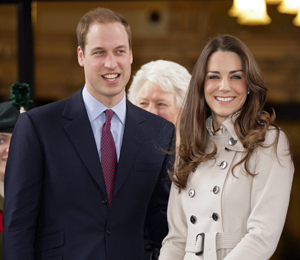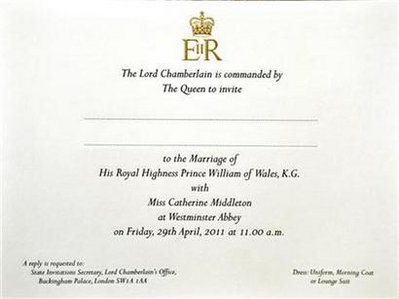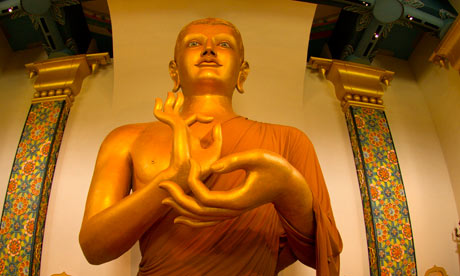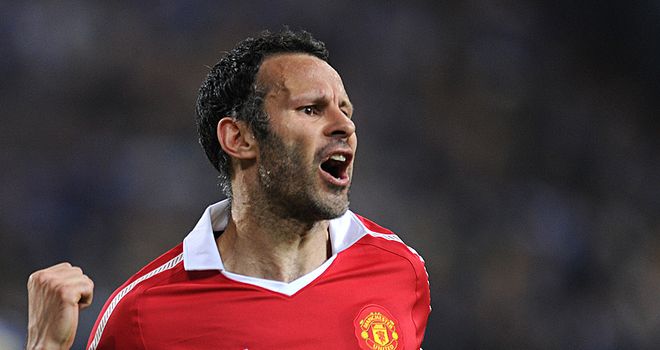High in the mountains of northern Colorado, a 100-foot tall
tower reaches up through the pinetops. Brightly coloured and strung with
garlands, its ornate gold leaf glints in the sun. With a shape that
symbolises a giant seated Buddha, this lofty stupa is intended to
inspire those on the path to enlightenment.
Visitors here to the
Shambhala Mountain Centre meditate in silence for up to 10 hours every
day, emulating the lifestyle that monks have chosen for centuries in
mountain refuges from India to Japan. But is it doing them any good? For
two three-month retreats held in 2007, this haven for the eastern
spiritual tradition opened its doors to western science. As attendees
pondered the "four immeasurables" of love, compassion, joy and
equanimity, a laboratory squeezed into the basement bristled with
scientific equipment from brain and heart monitors to video cameras and
centrifuges. The aim: to find out exactly what happens to people who
meditate.
After several years of number-crunching, data from the so-called
Shamatha project
is finally starting to be published. So far the research has shown some
not hugely surprising psychological and cognitive changes –
improvements in perception and wellbeing, for example. But one result in
particular has potentially stunning implications: that by protecting
caps called telomeres on the ends of our chromosomes,
meditation might help to delay the process of
ageing.
It's
the kind of claim more often associated with pseudoscience. Indeed,
since researchers first started studying meditation, with its close
links to religion and spirituality, they have had a tough time gaining
scientific credibility. "A great danger in the field is that many
researchers are also meditators, with a feeling about how powerful and
useful these practices are," says Charles Raison, who studies mind-body
interactions at Emory University in Atlanta. "There has been a tendency
for people to be attempting to prove what they already know."
But a
new generation of brain-imaging studies and robust clinical trials is
helping to change that. Scientists from a range of fields are starting
to compile evidence that rather than simply being a transient mental or
spiritual experience, meditation may have long-term implications for
physical health.
There are many kinds of meditation, including
transcendental meditation, in which you focus on a repetitive mantra,
and compassion meditation, which involves extending feelings of love and
kindness to fellow living beings. One of the most studied practices is
based on the Buddhist concept of mindfulness, or being aware of your own
thoughts and surroundings. Buddhists believe it alleviates suffering by
making you less caught up in everyday stresses – helping you to
appreciate the present instead of continually worrying about the past
or planning for the future.
"You pay attention to your own
breath," explains Sara Lazar, a neuroscientist who studies the effects
of meditation at Massachusetts general hospital in Boston. "If your mind
wanders, you don't get discouraged, you notice the thought and think,
'OK'."
Small trials have suggested that such meditation creates
more than spiritual calm. Reported physical effects include lowering
blood pressure, helping psoriasis to heal, and boosting the immune
response in vaccine recipients and cancer patients. In a pilot study in
2008, Willem Kuyken, head of the Mood Disorders Centre at Exeter
University, showed that mindfulness meditation was more effective than
drug treatment
in preventing relapse in patients with recurrent depression. And in 2009, David Creswell of Carnegie Mellon University in Pittsburgh found that it
slowed disease progression in patients with HIV.
Most
of these trials have involved short courses of meditation aimed at
treating specific conditions. The Shamatha project, by contrast, is an
attempt to see what a longer, more intensive course of meditation might
do for healthy people. The project was co-ordinated by neuroscientist
Clifford Saron of the Centre for Mind and Brain at the University of
California, Davis. His team advertised in Buddhist publications for
people willing to spend three months in an intensive meditation retreat,
and chose 60 participants. Half of them attended in the spring of 2007,
while the other half acted as a control group before heading off for
their own retreat in the autumn.
It sounds simple enough, but the
project has taken eight years to organise and is likely to end up
costing around $4m (partly funded by private organisations with an
interest in meditation, including the Fetzer Institute and the Hershey
Family Foundation). As well as shipping laptops all over the world to
carry out cognitive tests on the volunteers before the study started,
Saron's team built a hi-tech lab in a dorm room beneath the Shambhala
centre's main hall, enabling them to subject participants and controls
to tests at the beginning, middle and end of each retreat, and worked
with "a village" of consulting scientists who each wanted to study
different aspects of the meditators' performance. "It's a heroic
effort," says neuroscientist Giuseppe Pagnoni, who studies meditation at
the University of Modena and Reggio Emilia in Italy.
Many of the
tests focused on changes in cognitive ability or regulation of emotions.
Soft white caps trailing wires and electrodes measured the meditators'
brain waves as they completed gruelling computerised tasks to test their
powers of attention, and video recordings captured split-second changes
in facial expressions as they watched images of suffering and war.
But
psychologist Elissa Epel, from the University of California, San
Francisco (UCSF), wanted to know what the retreat was doing to the
participants' chromosomes, in particular their telomeres. Telomeres play
a key role in the ageing of cells, acting like a clock that limits
their lifespan. Every time a cell divides, its telomeres get shorter,
unless an enzyme called telomerase builds them back up. When telomeres
get too short, a cell can no longer replicate, and ultimately dies.
It's
not just an abstract concept. People with shorter telomeres are at
greater risk of heart disease, diabetes, obesity, depression and
degenerative diseases such as osteoarthritis and osteoporosis. And they
die younger.
Epel has been collaborating with UCSF's Elizabeth
Blackburn, who shared the 2009 Nobel physiology or medicine prize for
her work on telomeres, to investigate whether telomeres are affected by
psychological factors. They found that at the end of the retreat,
meditators had
significantly higher telomerase activity
than the control group, suggesting that their telomeres were better
protected. The researchers are cautious, but say that in theory this
might slow or even reverse cellular ageing. "If the increase in
telomerase is sustained long enough," says Epel, "it's logical to infer
that this group would develop more stable and possibly longer
telomeres over time."
Pagnoni has previously used brain imaging to show that meditation may
protect against the cognitive decline
that occurs as we age. But the Shamatha project is the first to suggest
that meditation plays a role in cellular ageing. If that link is
confirmed, he says, "that would be groundbreaking".
So how could
focusing on your thoughts have such impressive physical effects? The
assumption that meditation simply induces a state of relaxation is "dead
wrong", says Raison. Brain-imaging studies suggest that it triggers
active processes within the brain, and can cause physical changes to the
structure of regions involved in learning, memory, emotion regulation
and cognitive processing.
The question of how the immaterial mind
affects the material body remains a thorny philosophical problem, but on
a practical level, "our understanding of the brain-body dialogue has
made jaw-dropping advances in the last decade or two," says Raison. One
of the most dramatic links between the mind and health is the
physiological pathways that have evolved to respond to stress, and these
can explain much about how meditation works.
When the brain
detects a threat in our environment, it sends signals to spur the body
into action. One example is the "fight or flight" response of the
nervous system. When you sense danger, your heart beats faster, you
breathe more rapidly, and your pupils dilate. Digestion slows, and fat
and glucose are released into the bloodstream to fuel your next move.
Another stress response pathway triggers a branch of the immune system
known as the inflammatory response.
These responses might help us
to run from a mammoth or fight off infection, but they also damage body
tissues. In the past, the trade-off for short bursts of stress would
have been worthwhile. But in the modern world, these ancient pathways
are continually triggered by long-term threats for which they aren't any
use, such as debt, work pressures or low social status. "Psychological
stress activates these pathways in exactly the same way that infection
does," says Raison.
Such chronic stress has devastating effects,
putting us at greater risk of a host of diseases including diabetes,
cancer, heart disease, depression – and death. It also affects our
telomeres. Epel, Blackburn and their colleagues found in 2004 that
stressed mothers caring for a chronically ill child
had shorter telomeres than mothers with healthy children. Their stress had accelerated the ageing process.
Meditation
seems to be effective in changing the way that we respond to external
events. After short courses of mindfulness meditation, people produce
less of the stress hormone cortisol, and mount a smaller inflammatory
response to stress. One study linked meditators' lower stress to changes
in the amygdala – a brain area involved in fear and the response to
threat.
Some researchers think this is the whole story, because
the diseases countered most by meditation are those in which stress
plays a major role. But Epel believes that meditation might also trigger
"pathways of restoration and enhancement", perhaps boosting the
parasympathetic nervous system, which works in opposition to the fight
or flight response, or triggering the production of growth hormone.
In
terms of the psychological mechanisms involved, Raison thinks that
meditation allows people to experience the world as less threatening.
"You reinterpret the world as less dangerous, so you don't get as much
of a stress reaction," he says. Compassion meditation, for example, may
help us to view the world in a more socially connected way. Mindfulness
might help people to distance themselves from negative or stressful
thoughts.
The Shamatha project used a mix of mindfulness and
compassion meditation. The researchers concluded that the meditation
affected telomerase by changing the participants' psychological state,
which they assessed using questionnaires. Three factors in particular
predicted higher telomerase activity at the end of the retreat:
increased sense of control (over circumstances or daily life); increased
sense of purpose in life; and lower neuroticism (being tense, moody and
anxious). The more these improved, the greater the effect on the
meditators' telomerase.
For those of us who don't have time for
retreats, Epel suggests "mini-meditations" – focusing on breathing or
being aware of our surroundings – at regular points throughout the day.
And though meditation seems to be a particularly effective route to
reducing stress and protecting telomeres, it's not the only one. "Lots
of people have no interest in meditation, and that's fine," says
Creswell. Exercise has been shown to buffer the effects of stress on
telomeres, for example, while stress management programmes and writing
emotional diaries can help to delay the progression of HIV.
Indeed,
Clifford Saron argues that the psychological changes caused by the
Shamatha retreat – increased sense of control and purpose in life – are
more important than the meditation itself. Simply doing something we
love, whether meditating or gardening, may protect us from stress and
maybe even help us to live longer. "The news from this paper is the
profound impact of having the opportunity to live your life in a way
that you find meaningful."
For a scientific conclusion it sounds
scarily spiritual. But researchers warn that in our modern,
work-obsessed society we are increasingly living on autopilot, reacting
blindly to tweets and emails instead of taking the time to think about
what really matters. If we don't give our minds a break from that
treadmill, the physical effects can be scarily real.
 Whether you will
be watching every moment or just want to see the ceremony, Yahoo! will
be your one stop for all royal
wedding updates. You won't miss a thing. Here's what you can
expect:
Whether you will
be watching every moment or just want to see the ceremony, Yahoo! will
be your one stop for all royal
wedding updates. You won't miss a thing. Here's what you can
expect:















 final at Wembley after second-half goals from Giggs and
final at Wembley after second-half goals from Giggs and 
